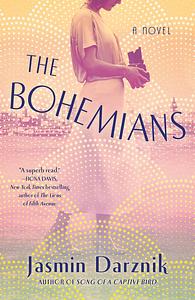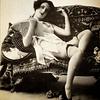You need to sign in or sign up before continuing.
Take a photo of a barcode or cover
The Bohemians is a fictional account of Dorothea Lange’s early career. While I was familiar with some of DL’s Depression era photos, I was not at all familiar with her life. The struggles for a woman to establish her own business, the prejudices against Asian Americans, the strength of female friendships are all explored in this beautifully written novel.
Many of us are familiar with Dorothea Lange’s haunting photographs of migrant workers and other down-and-out folks during the Depression. But for several years before she took her camera on the road, she was a successful portrait photographer in San Francisco. The Bohemians lovingly recreates the city ten years after the 1906 quake, when “bohemians” flourished, even amidst the war, pandemic, and an atmosphere of anti-Chinese propaganda. Darznik focuses on the friendship between Dorothea and her “assistant” whose true identity has been lost to history, choosing to render her as a half-Chinese dressmaker, whose beauty and generosity charm Dorothea.
Replete with historical figures and with actual events that echo into the present day, the novel is strongest when it focuses on the women’s connection as they build a portrait studio and explore the city together, “because that’s the sort of thing San Francisco does: hands you a costume and sets you free.”
This novel will be thoroughly enjoyed by readers who love historical fiction and by the many people who regard San Francisco as their mecca, their calling, their dream city.
Replete with historical figures and with actual events that echo into the present day, the novel is strongest when it focuses on the women’s connection as they build a portrait studio and explore the city together, “because that’s the sort of thing San Francisco does: hands you a costume and sets you free.”
This novel will be thoroughly enjoyed by readers who love historical fiction and by the many people who regard San Francisco as their mecca, their calling, their dream city.
I read #thebohemians in a day. Such a touching story of an artist I knew of, but didn’t really know. #dorothealange is an amazing #photographer and I’m very familiar with her with, but wasn’t with her name! Thank you @jdarznik for allowing me to take a personal look into this amazing human being. I also found out, I share a birthday with Dorothea! May 26th!!!
#fivestars #booknerd
Pub Date: 04/06/2021
#fivestars #booknerd
Pub Date: 04/06/2021
slow-paced
Plot or Character Driven:
Plot
Strong character development:
Yes
Loveable characters:
Yes
Loved the chronicle of San Francisco and the relationship between dory and Carolyn
hopeful
informative
medium-paced
Plot or Character Driven:
A mix
Strong character development:
Yes
Loveable characters:
Yes
Diverse cast of characters:
Complicated
Flaws of characters a main focus:
No
I enjoyed this book, but I have to admit to mixed feelings. It was pitched as a "literary portrait of Dorothea Lange," so, as a photographer who has long admired this icon, I wanted more story on the development of this profoundly impactful woman photographer. I wanted a story about how she related to her camera and how she used it to relate to other people, cultural and economic oppression and storytelling in a time that such a vocation was highly unusual for a woman.
The story finally alluded to her finding her artistic voice -- the one she's known for -- in the last 9 pages of a 317 page book, and even then it was treated more as an afterthought.
But, the title is "The Bohemians" and I get that the author was trying to explore something different with the content. In this, it was a well told story about San Fransisco, the artists and influencers who shaped its growth and regrowth in the wake of the great earthquake, the 1918-19 flu pandemic, racism and riots.
The most compelling characters to me ended up being those around her, including Caroline Lee (Dorothea's best talented, brave Chinese-American friend during this phase of her life) and Donaldina Cameron, a fierce woman who, as I learned in the historical notes went on to help "eradicate the slave trade that flourished into the 1930's in San Francisco and also helped enact state and federal laws for Chinese people across the US."
I put down the book disappointed in what I didn't learn about the photographer, and wishing the protagonist had instead been either Donaldina or Caroline. I couldn't help but wonder what it would have been like to share this story through THEIR eyes, their voices. That would have been quite compelling on it's own.
I'm still giving four stars because I recognize that my disappointment was directly related to my personal hopes and expectations hoping for a story about the self-discovery of an artist and photographer. And for what it's worth I did very much enjoy getting lost in the details of San Francisco in the time of the Bohemians.
The story finally alluded to her finding her artistic voice -- the one she's known for -- in the last 9 pages of a 317 page book, and even then it was treated more as an afterthought.
But, the title is "The Bohemians" and I get that the author was trying to explore something different with the content. In this, it was a well told story about San Fransisco, the artists and influencers who shaped its growth and regrowth in the wake of the great earthquake, the 1918-19 flu pandemic, racism and riots.
The most compelling characters to me ended up being those around her, including Caroline Lee (Dorothea's best talented, brave Chinese-American friend during this phase of her life) and Donaldina Cameron, a fierce woman who, as I learned in the historical notes went on to help "eradicate the slave trade that flourished into the 1930's in San Francisco and also helped enact state and federal laws for Chinese people across the US."
I put down the book disappointed in what I didn't learn about the photographer, and wishing the protagonist had instead been either Donaldina or Caroline. I couldn't help but wonder what it would have been like to share this story through THEIR eyes, their voices. That would have been quite compelling on it's own.
I'm still giving four stars because I recognize that my disappointment was directly related to my personal hopes and expectations hoping for a story about the self-discovery of an artist and photographer. And for what it's worth I did very much enjoy getting lost in the details of San Francisco in the time of the Bohemians.
Wow, this breathtaking historical novel really transported me to the early 1900s San Francisco with Dorothea Lange. The descriptions are so rich you really feel like you are right there in San Francisco with Lange and her community. I absolutely loved the friendship between Lange and Caroline Lee, who absolutely stole my heart. Although this story is set around 100 years ago, there are so many parallels to current day - there is the Spanish flu going around with descriptions of masks and people falling ill in waves across the country. There is the threat of the Yellow Peril which mirrors the anti-Asian hate crimes and sentiments that also feel so timely. Those are only 2 examples but there are more that I won't share to avoid any spoilers because everyone should pick this one up! Living in the Bay Area, it felt almost like San Francisco was another character in this book with the descriptions of many of the different areas of the city. I loved Song of a Captive Bird and this one met and exceeded all my hopes of Darznik's newest book. Pick this one up now , you won't regret it!
I know virtually nothing (hadn't even heard of her in fact) of Dorothea Lange. But I read the book Song of the Captive Bird by this author and knew I'd love reading this one. I love the San Francisco setting, it's got to be one of my favorite places ever.
Dorothea (once contracted polio as a 7 year old that results in a limp) leaves her home of New Jersey for San Fransisco. She is immediately robbed of all her money. She meets a girl Caroline who takes her to her apartment on what's known as Monkey Block. This is a place for the Bohemians- artists of all kinds.
Dorothea convinces a gentleman to help back her in opening a portrait studio because "women don't run their own businesses around here". Caroline becomes her assistant to the taking of portraits to the elite of San Francisco.
There are prejudices against Caroline as she is part Asian (they use Oriental in the book because that's what they used back then-the derogatory name is it now). So we see a lot of how she deals with it and how Dorothea does. There is also the 2 years of Spanish Influenza that sweeps across the country. (So eerie to today's pandemic...I also thought while reading... Why haven't we learned from the past?)
This was enjoyable but hard at times to read. I think lovers of real historical figures will enjoy this look into a world renowned documentary photographer.
Dorothea (once contracted polio as a 7 year old that results in a limp) leaves her home of New Jersey for San Fransisco. She is immediately robbed of all her money. She meets a girl Caroline who takes her to her apartment on what's known as Monkey Block. This is a place for the Bohemians- artists of all kinds.
Dorothea convinces a gentleman to help back her in opening a portrait studio because "women don't run their own businesses around here". Caroline becomes her assistant to the taking of portraits to the elite of San Francisco.
There are prejudices against Caroline as she is part Asian (they use Oriental in the book because that's what they used back then-the derogatory name is it now). So we see a lot of how she deals with it and how Dorothea does. There is also the 2 years of Spanish Influenza that sweeps across the country. (So eerie to today's pandemic...I also thought while reading... Why haven't we learned from the past?)
This was enjoyable but hard at times to read. I think lovers of real historical figures will enjoy this look into a world renowned documentary photographer.
TW: sexual assault, racism
"When I was younger, I wanted to talk in the world as if I were invisible, but slowly I cam to realize you couldn't really see people if you're bent on hiding all the time. You had to show people who you were if you hoped they'd show you something of themselves. You had to let yourself be seen. If you gave a person that as well as your deepest attention and then waited, sometimes you could capture their secret stories."
The Bohemians is one of the most unique historical fiction novels I have picked up, ever. Jasmin Darznik takes the reader back to a time that not many people know about, and she does it in a way that makes you want to know more and more and more. Prior to reading this novel, I knew little to nothing about the life of photographer Dorothea Lange and was also unaware of the artistic movement that happened in the 1920s in San Francisco. As a result of reading this novel, I can't wait to learn more.
This is a book that is set in a time so starkly different than the times we live in currently and yet, there has never been a more important time than now to recognize the parallels of history to our present day. Darznik writes about the blatant class discrimination of the 1920s while also reminding the readers of America's history with isolationist and America-first politics. Reading about the impacts of the Spanish Flu on culture, society, and identity was absolutely haunting.
I highly recommend for any fans of historical fiction. The friendship between Dorrie and Caroline is beautiful. The resilience is powerful. And, the cameos of well known artists such as Frida Kahlo, Diego Rivera and Ansel Adams create a little fun for the reader as well.
"When I was younger, I wanted to talk in the world as if I were invisible, but slowly I cam to realize you couldn't really see people if you're bent on hiding all the time. You had to show people who you were if you hoped they'd show you something of themselves. You had to let yourself be seen. If you gave a person that as well as your deepest attention and then waited, sometimes you could capture their secret stories."
The Bohemians is one of the most unique historical fiction novels I have picked up, ever. Jasmin Darznik takes the reader back to a time that not many people know about, and she does it in a way that makes you want to know more and more and more. Prior to reading this novel, I knew little to nothing about the life of photographer Dorothea Lange and was also unaware of the artistic movement that happened in the 1920s in San Francisco. As a result of reading this novel, I can't wait to learn more.
This is a book that is set in a time so starkly different than the times we live in currently and yet, there has never been a more important time than now to recognize the parallels of history to our present day. Darznik writes about the blatant class discrimination of the 1920s while also reminding the readers of America's history with isolationist and America-first politics. Reading about the impacts of the Spanish Flu on culture, society, and identity was absolutely haunting.
I highly recommend for any fans of historical fiction. The friendship between Dorrie and Caroline is beautiful. The resilience is powerful. And, the cameos of well known artists such as Frida Kahlo, Diego Rivera and Ansel Adams create a little fun for the reader as well.
I don't know much about Dorothea Lange and spent a lot of this book wondering how much was true and how much was fictionalized. It was also a shock to have the story switch abruptly into an overview of the rest of her life. I realized after a bit that the story had intended to focus on her early days in San Francisco but the author didn't want to leave the reader hanging without including the rest of her life. Too bad because I could have read another couple hundred pages!





